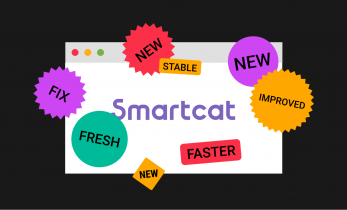Greater than 4 minutes, my friend!
How the Internet has changed the way online content gets translated
The way companies publish online content has changed over the past few years and with it the way translation gets done. I have been translating online content since 2008 and the way I translate today is completely different from the way I worked back then. True, at the time I didn’t even have a translation software. But that’s not what’s changed since 2008.
My first big project was a website targeted at expectant mothers, compiling data and useful information. From scientific data to other moms’ advice, it was a hub of information. And it already had lots of content. So, in order to translate this website, I worked on a Word document, where the entire HTML code had been copy/pasted. It took me a few weeks and by the end of the project, I could read between the tags and thought I was HTML fluent :-). I’m not telling this story to complain about the time it took to translate text between HTML codes. Today CAT tools do a great job of removing the tags and leaving only translatable content. No, my point is: the way content gets published online influences the way translators work (if they specialize in online content).
Back in the day, to publish websites, most companies would type up their content in a Word document or another program, design the page in a web design software and publish the pages through FTP. And websites definitely didn’t look like they do today. So for translators, the task was easy: get the source HTML files from the client, import them in a CAT tool and start translating.
Up until 2012, this is the way I worked. And then, I was introduced to online Translation Management Systems by one of my clients. At first, I thought it was just a modern CAT tool which allowed a few translators to work on the same project while keeping the translation consistent throughout. But it’s more than that. The online TMS platforms are aligned with the way content gets published today and some of them even have integrations with the most popular CMS. TMS platforms extract content from a website and remove the need for copy-pasting, sending emails and importing files.
Now let’s move on to 2015: I am working with a few online TMS supplied by my clients and I’m a happy translator. And then, I receive an email from a travel company which said something like that: “Hello, we would like to have our website translated into French. Could you give us your deadline and your rate please?” Easy right? Not so much. After a quick look at the company’s website, I found out there were a dozen pages, with a lot of content. Blogs posts, pages for each tour offered by the travel agent, news etc. In that case, what would you have done? Try to estimate the volume of work required right? So here I was copy-pasting the content into a Word document to get an idea of how long it would take to translate, before even talking about rates. After an hour or so of copy-pasting, I realized the content was never ending, and I was likely to forget some. There were sidebars, menus, and probably other content not showing up online (like the SEO meta data, pop-up window content, dialogs etc).
So my first reply to the client was “Do you have the source files?” which in retrospect, seems so 2008. The client replied that they had an external partner for their online content so they didn’t have the source files. And this is how I found myself in this paradox.
A potential client had contacted me for a project that I would have been happy to take, and which completely fit my experience and skills. And yet, I was unable to give them a deadline and a total price.
I ended up advising this client to check out an online TMS which would have streamlined the translation process and made their back-end job so much easier. The client never replied. After a few follow-up emails throughout the year, I didn’t get any answer, and today the website is still in English only. There might be a lot of reasons why this company decided to abort the translation mission. However, I would hate it if technology was the reason.
A company willing to expand internationally and what’s more, willing to translate their content should be able to do so.
And we shouldn’t have to copy/paste online content from a WordPress page to a Word document. Not in 2016. While most companies today, not familiar with the field of translation, might be aware of online TMS platforms, there are new companies on the market every day. Try to look for a solution to get your website in a few languages and you will find many, many providers available. From WordPress plugins (WPML, qTranslate and others) to TMS platforms that index your translatable content, technology is there to make the developers’ and translators’ jobs easier.
If you’re a translator and you translate online content, you probably know all of this. And you probably work on a TMS platform like Smartling, Memsource, WebTranslateIt or SDL WorldServer among others, provided by your clients, and don’t have to think about the back-end work of indexing content. If you’re new to the industry and want to specialize in online content, then get familiar with those platforms because as technology is evolving, so will the translation process.
If you’re a company looking to have your website translated (and we’re not even talking about mobile apps), then in addition to your CMS, which are now part of your world, you will need to think about getting a TMS platform. I’m not here to promote any particular TMS platform, although I do have my favorite, but to root for TMS platforms. For having translated content directly in WordPress, copy-pasted online content before translating it offline (and then having a developer copy-paste it back), I can’t say it enough: a TMS platform will save you so much time. And we all know time is money.
And finally, if you’re a TMS platform provider, to differentiate yourself from other platforms, try to have both the end client and the translator’s interests in mind. I know it’s easier said than done, and I’m not a developer. But since the benefit of a TMS is first to save time, it should both save time to the end client AND the translator. Technology is here, and I believe we should all embrace it to make everybody’s job easier.





Stephanie, nice overview. You explain very well the trouble translating a website was 10 years ago, and how things have changed & improved.
I think you should make a distinction between online tools that help translators to translate, and maybe also work together, sharing the job memory and the terminology, and tools that we call translation proxies. Those tools capture the translatable content (or most of it) and allow a translator to translate it in context. This in itself is a great help. Some of these tools have an internal workflow system that pre-processes the text (via a TM and/or MT engine), auto-propagates the work of the translator in real time, pulls in a reviewer when the translator delivers, and creates a sign-off step for the customer. Some of these tools are also acting as a job portal for translators and the word price is not always great.
Still the challenge to turn online content into translatable content isn’t over: texts that are in scripts are not always captured by translation proxies, and often it are those scripts that interact with the user. Also the redesign of the webpage for Arabic or Asian languages is still not easy. HTML5 makes it feasible, but not a lot of web developers care about translation troubles. (between brackets: one of the features I like most in HTML5 is that there is translation process support: take a look at this: CONTINUE).
A bit of topic, maybe, but I want to mention 3 internet induced changes that influence our work:
– there is more “content” to translate (subtitles, games…); there’s more online than websites.
– the global competition: translation buyers who want to buy cheap will always find someone who can do the job for less money. Translation brokers are having a great time 🙁
– real time translation (streaming) will cause more stress. Language is very valuable and translation should not be done under “time pressure by design”. I’m happy that services like these don’t take off very well.
I like your last remark a lot. It is not easy indeed to make a TMS that is as powerful and helpful to a translator as an off-line CAT. Luckily there are some off-line CATs that work well with online TMS tools.
Hi Gert,
Thanks a lot for your comments. I appreciate your explanation on the difference between online translation tools and translation proxies. I guess I have been working on a mix of the two and was not explicitly thinking of them as two different systems. I really enjoy what the technology has enabled here.
I have always wanted to know what happens before the translator receives the text, all the steps beforehand in the workflow but unfortunately I do not work internally for my clients and just see the front-end part of the job.
I wouldn’t say developers do not care about translation troubles at all but the fact that translators are not often brought in on the back-end steps, when the content gets indexed, can bring crazy results for the end user. I use to have a client who converted different activity types as placeholders but those were nouns in English and ended up being translated as verbs in most languages. In the end, since those placeholders were used in a lot of places, everything is messed up in the app and there is almost no way of fixing it (as per the client) since it all happened at the coding stage. That’s why I’m so interested in learning more about the technology behind all of this.
And I definitely agree with the way Internet has brought us more content to translate, and with the rise of mobile apps and videos I do not see this trend changing at all. About the global competition, true, some clients will always find a way to get a cheaper provider but that is worth for literally every service out there. I do think there is a way to showcase our knowledge, expertise and approach to the world and there are still clients who care, care about grammar, double spaces, a change in terminology and who will not buy in to those low-cost solutions.
Stephanie
Amazing post, Stephanie! Congrats on publishing your first Open Mic story 🙂 I love website localization, especially when I get a chance to work in a TMS. The only thing that missing in the industry in my humble opinion is a TMS that would allow bringing translators and clients together.
All of the solutions I’ve tried are focused mostly on translation agencies and often cost a lot of money. It’s a shame because like you’ve said translators should be involved in the backend and work closely with the developers to avoid those costly mistakes that you’ve described.
One of the tools I was trying to work with was Easyling. I was hoping I’ll be able to integrate this solution into my workflow and offer a one-stop solution for those type of clients who need their website localized, but have no idea how to do it, don’t have the source files and don’t want to bother with all the technical details.
For those types of clients Translation Proxy seems like a wonderful solution because it takes almost all of the technical pains away (Easyling even allows modifying or adding custom scripts I believe). But the problem is that a one-man translation business simply cannot afford the cost of such solution. For example, even if I’m just giving a quote to a client and scanning his website to identify translatable content I have to pay Easyling even if I don’t get the job. And if I want a white label solution, that’s another 200+ USD per month.
Translation and website localization technologies are evolving rapidly and I’m really excited about the future, I just wish technology companies could offer something to small LSPs like myself and thousands of other professional translators interested in website localization. I think we could’ve brought a lot of value too. After all we’re the ones doing the actual job. Why not give us the opportunity to explore the full potential of the technology and let us use it?
Thanks a lot for your input Dmitry.
I agree with you, I’ve been looking for a while now for a way of offering a one-stop-shop for prospects who are just looking to have their website translated and who do not want to know the details of it. I seriously believe there is a huge potential for tech companies to get on this and release a great solution to bring together clients and translators.
I was recently looking into registering for a free trial into one of these solutions, but then it looks like you’re limited to 1,500 segments. I don’t think freelance translators should pay to access these tools and be able to work. But SMEs are not fully aware of these solutions in the first place and end up going to big translation agencies because they probably don’t want to deal with this time-consuming process. All in all I’m sure there are many small companies who do not have the budget for large LSPs and have no idea where to start. A solution allowing translators and boutique agencies to meet SMEs needs would be a winner.